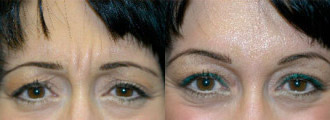Trust your Face to a Facial Plastic Surgeon
Skin Cancer Reconstruction in Scottsdale, AZ
Conveniently Located to Serve Phoenix, Scottsdale, Mesa, and Tempe
Jump to
 Skin Cancer Reconstruction & Scar Revision Surgery
Skin Cancer Reconstruction & Scar Revision Surgery
If you’ve had a cancerous growth removed from your face, particularly if it’s large, or you’ve scheduled Mohs surgery with your dermatologist, you will likely want to see a facial plastic surgeon for skin cancer reconstruction in Scottsdale to correct the scarring that will occur.
When the Mohs surgery repair technique is used for skin cancer reconstruction, healthy skin flaps or skin grafts are often utilized. In the case of large facial cancer, free tissue transfer is commonly used for repair.
During skin cancer reconstructive surgery, bone, muscle, or skin is taken from the patient’s body and used to repair the facial defect.
- Facts About Treatment for Skin Cancer
- Facial Scar Surgery
- How to Know if Facial Scar Treatment is Right For You
- Deciding to Have Scar Revision Surgery
- Skin Cancer Reconstructive Surgery Procedures
- What to Expect Following the Surgery
- Skin Cancer Reconstruction Cost
- Schedule a Consultation
Facts About Treatment for Skin Cancer
- The treatment of skin cancer is similar to the treatment of other forms of cancer: surgery is often required in order to remove the cancerous growths.
- A facial plastic surgeon or dermatologist can remove the cancerous growths, as well as other types of skin lesions. Thanks to specialized techniques, your appearance and health will be preserved.
- While most surgery results in some type of scarring, a facial plastic surgeon will do their best to repair your skin without altering your appearance.
- For some patients, reconstructive plastic surgery or Mohs reconstructive surgery may require multiple procedures in order to achieve desired results.
Facial Scar Surgery
As the skin recovers from an injury, accident, burn, or acne, scarring occurs where the layers of the skin have been damaged. When a scar appears, it’s permanent. However, with plastic surgery after skin cancer removal, scars can be relocated or made less noticeable.
If you’re self-conscious about your facial scars, you’re not alone. Most patients are under-confident when it comes to scarring. Also, some patients notice a decline in facial functioning because of their scars.
Problems can occur around the eyes, nose, or mouth, requiring various types of procedures, including nose reconstruction after skin cancer. Facial scar revision can improve more than just your appearance; it can also help restore your facial functioning.
The most successful facial plastic surgeries begin with a good relationship between the patient and the surgeon. Realistic expectations and solid medical expertise result in trust between both parties. This trust will start to develop during consultations; it’s important for a patient to trust their surgeon long before the surgery is actually performed. During the consulting phase, your surgeon will be able to answer any questions you have.
How to Know if Facial Scar Treatment is Right For You
For any type of surgery, a basic requirement is good health. Additional requirements are dependent upon the type of surgery being performed and the patient. These prerequisites will be discussed in detail during your consultations, and may include type of skin, skin color, age, and type of scarring.
It’s important to form realistic expectations of the surgery. When considering facial scar revision, it’s important to understand that the scars won’t be 100% removed. Instead, the goal of the surgery is to improve appearance, which is done by either relocating, minimizing, or disguising the scar.
There are many different types of scars, and they all respond differently to plastic surgery. The timing of when you have the surgery is also important. For example, many surgeons recommend waiting for one year after an injury to move forward with scar revision surgery. By waiting for one year, you can let your body heal before undergoing surgery.
Deciding to Have Scar Revision Surgery
The choice to have facial scar revision surgery, whether it’s for aesthetic or functional purposes, is a huge decision. A facial plastic surgeon will examine your scarring in order to decide which type of treatment is right for you. After a consultation, you will be given information about what to expect during and after surgery and directions for postoperative care.
The type of scar you have will determine your treatment. Burns, for example, often destroy broad sections of skin, making the skin pucker when it heals. This can affect the muscles and tendons, because the skin contracts as it heals.
Keloid scars are common after a wound has healed, due to the production of too much collagen. Keloid scars often look like growths. Alternatively, hypertrophic scars don’t grow beyond the scar area. However, these scars are raised and thick, which can be unsightly. Also, they sometimes restrict movement of the tendons and muscles.
Facial scarring is often unattractive because of its location. Additionally, some facial scars can affect expressions. Surgical techniques and possibilities, along with risks, will be discussed during your consultation. You will not proceed with the surgery until you and your surgeon have made an agreement. Once you decide to move forward with the surgery, you’ll be told about anesthesia, the facility where you’ll have the surgery, costs, and surgery options.
Skin Cancer Reconstructive Surgery Procedures
If you have a contracture-type scar, facial revision surgery will involve removing all of the scar tissue. Skin flaps, which are made up of healthy, unscarred skin, are lifted and moved. If a flap isn’t possible, skin grafts will be used. Grafts take a part of the skin tissue from one area of the body and attach it to another area of the body. After surgery, time is required to let new blood vessels and new soft tissue form.
To move a scar from one part of the skin to another, Z-plasty is used. The scar is moved into a skin crease or fold, which minimizes the scar’s visibility. Z-plasty doesn’t remove the scar entirely, but it does make it much less noticeable.
Rough, elevated scars can be made less noticeable with laser resurfacing or dermabrasion. The upper layers of the skin are removed, making the scar smoother and less obvious. Hypertropic or keloid scars are first treated with steroid injections to reduce their size. Or, the scars can be surgically removed.
What to Expect Following the Surgery
Discomfort is normal after facial surgery. Swelling, redness, and bruising are also normal. Follow your surgeon’s after-surgery care recommendations. The sutures will be removed a few days after surgery, but it will take longer for your skin to heal completely.
Keep your head elevated when lying down and limit activity during recovery. Cold compresses can be used to reduce swelling. Any type of activity that places stress on the surgery site should be avoided. Never take medication after surgery without first consulting your doctor. Scar tissue requires at least one year to fully heal.
To develop a better understanding of your potential results, view skin cancer reconstruction before and after photos in our gallery.
Skin Cancer Reconstruction Cost
While insurance doesn’t typically cover cosmetic surgeries, if a scar was caused by an injury of if you had a cancerous lesion removed, its price may be partially reimbursed for medical reasons. Discuss insurance and financing issues with our staff during your consultation.
Financing options are available through CareCredit and Prosper Healthcare Lending.
Schedule a Consultation
To learn more regarding skin cancer reconstruction, Scottsdale patients can contact the office of Dr. David Hecht. Dr. Hecht will be available to discuss the procedure in greater detail and can answer any questions you may have.
Patient Reviews
Click on the resources below to read reviews from patients of Dr. Hecht and his staff.










